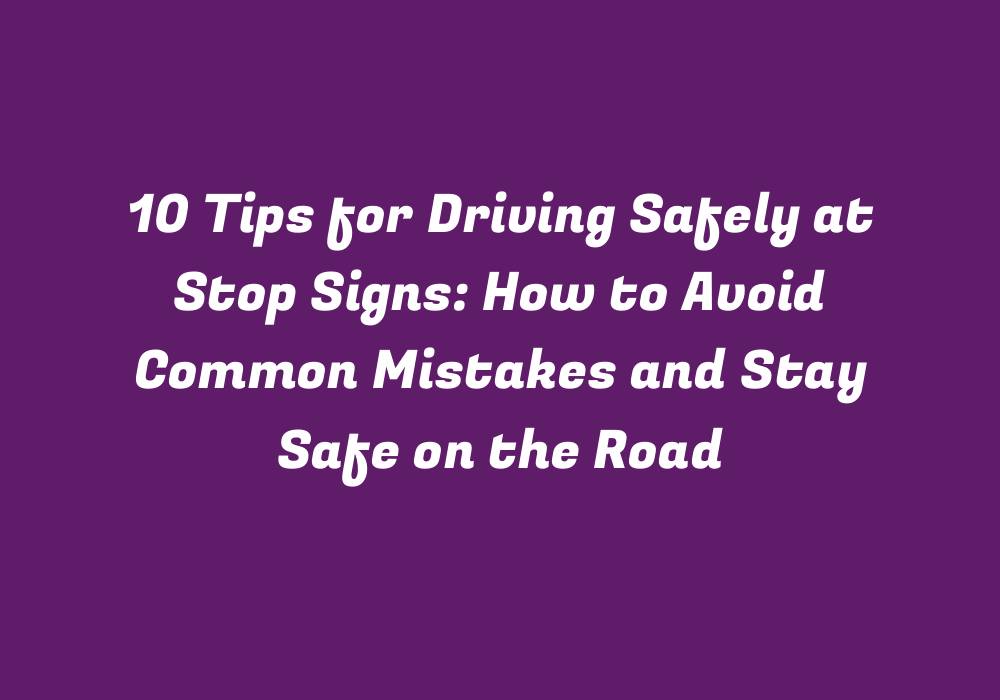10 Tips for Driving Safely at Stop Signs: How to Avoid Common Mistakes and Stay Safe on the Road
Stop signs are an essential part of traffic control, designed to make intersections safer by giving motorists a chance to stop and assess the situation before proceeding. However, many drivers tend to commit various errors at these junctions that can lead to accidents or near-misses on the road. To ensure safety for everyone involved, here are 10 useful tips to follow when approaching and navigating through stop signs.
1. Observe the Stop Line
The stop line, also known as the white strip at the intersection or crosswalk, marks the point where drivers must stop before proceeding. Many accidents occur due to vehicles failing to come to a complete halt behind this line or driving through it without stopping properly.
2. Check for Pedestrians and Cyclists
It is crucial to pay attention to pedestrians, cyclists, skaters, and other non-motorized traffic when approaching a stop sign, especially at intersections. Make sure you yield the right of way to these users if necessary.
3. Proceed with Caution
When the coast is clear and it’s safe to do so, proceed slowly through the intersection. Keep in mind that other drivers may not be paying attention or could still be stopping at the stop line. Make sure you remain vigilant as you navigate through the intersection to avoid any potential hazards.
4. Be Aware of Road Conditions
Wet, icy, or dark conditions can make it difficult for drivers to see other road users and traffic signals clearly. In such circumstances, take extra precautions while approaching stop signs to ensure your safety and the safety of others.
5. Stay Aware of Surroundings
As you approach a stop sign, constantly monitor your surroundings for any changes in traffic conditions or potential hazards like debris on the road or pedestrians crossing unexpectedly. This proactive approach can help prevent accidents and promote safety for everyone.
6. Avoid Rolling Stops
Avoid rolling stops, where drivers barely slow down before proceeding through a stop sign. These types of stops increase the risk of accidents by not giving you enough time to react to any last-minute changes in traffic or road conditions.
7. Maintain Proper Distance
Keep a safe distance between your vehicle and the one ahead of you at stop signs. This will provide adequate space for both vehicles to maneuver if needed, reducing the risk of rear-end collisions or other accidents.
8. Follow Traffic Signals
Sometimes traffic signals can overrule stop signs depending on the specific intersection and its surrounding infrastructure. Pay close attention to other traffic lights, as well as signs indicating special rules for certain intersections or turn lanes.
9. Be Patient
Remain patient while waiting at a stop sign, especially during peak traffic hours when the flow of vehicles can be heavy. Avoid impatiently driving through red lights or making unsafe right-on-red turns that could lead to dangerous situations.
10. Practice Defensive Driving
Defensive driving is a crucial component in staying safe at stop signs and all other intersections on the road. It involves anticipating the actions of other drivers, remaining alert, and being prepared to react appropriately in any given situation.
By following these tips and practicing safe driving habits when approaching and navigating through stop signs, you can help ensure your own safety and reduce the risk of accidents on the road. Remember that everyone’s focus should be on achieving a shared goal: keeping all road users safe as they travel to their destinations.
Conclusion
Stop signs are essential for maintaining order at intersections and promoting safety throughout our transportation system. By adhering to these 10 tips and being vigilant while driving, you can help minimize accidents, promote harmony among road users, and make the act of stopping at stop signs a valuable part of your everyday driving routine.
Blog Posts Related to this Topic
Improving Your Driving Skills: Essential Techniques for Safer Roads – Learn about the importance of regularly practicing and improving your driving skills to stay safe on the road.
Ultimate Guide to Navigating Roundabouts: Tips for Safe Circular Intersections – Discover how to safely and efficiently navigate through roundabouts, as they continue to replace traditional traffic lights in many areas.
The Impact of Driving Fatigue on Accident Prevention – Explore the dangers of driving while tired and how to recognize signs of fatigue, ultimately helping you stay alert behind the wheel.
Techniques for Reducing Road Rage: Maintaining a Calm Driving Experience – Learn how to manage your emotions and reactions while driving, resulting in a more peaceful and focused journey on the road.
Essential Dashboard Indicators and How They Affect Your Driving – Understand the importance of understanding your vehicle’s dashboard indicators in maintaining a safe driving experience.
Final Thoughts
By practicing these tips and regularly reviewing relevant blog posts, you can take proactive steps toward enhancing your road safety skills. Stay vigilant while approaching stop signs, interact with other road users respectfully, and remain alert throughout your entire driving experience to help prevent accidents and promote safe driving habits for everyone on the road.
